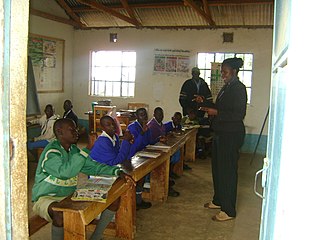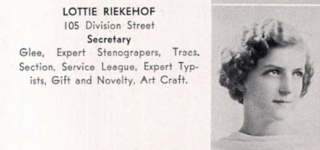
American Sign Language (ASL) is a natural language that serves as the predominant sign language of Deaf communities in the United States of America and most of Anglophone Canada. ASL is a complete and organized visual language that is expressed by employing both manual and nonmanual features. Besides North America, dialects of ASL and ASL-based creoles are used in many countries around the world, including much of West Africa and parts of Southeast Asia. ASL is also widely learned as a second language, serving as a lingua franca. ASL is most closely related to French Sign Language (LSF). It has been proposed that ASL is a creole language of LSF, although ASL shows features atypical of creole languages, such as agglutinative morphology.

William Clarence Stokoe Jr. was an American linguist and a long-time professor at Gallaudet University. His research on American Sign Language (ASL) revolutionized the understanding of ASL in the United States and sign languages throughout the world. Stokoe's work led to a widespread recognition that sign languages are true languages, exhibiting syntax and morphology, and are not only systems of gesture.

Deaf culture is the set of social beliefs, behaviors, art, literary traditions, history, values, and shared institutions of communities that are influenced by deafness and which use sign languages as the main means of communication. When used as a cultural label especially within the culture, the word deaf is often written with a capital D and referred to as "big D Deaf" in speech and sign. When used as a label for the audiological condition, it is written with a lower case d. Carl G. Croneberg coined the term "Deaf Culture" and he was the first to discuss analogies between Deaf and hearing cultures in his appendices C/D of the 1965 Dictionary of American Sign Language.
The history of deaf people and deaf culture make up deaf history. The Deaf culture is a culture that is centered on sign language and relationships among one another. Unlike other cultures the Deaf culture is not associated with any native land as it is a global culture. By some, deafness may be viewed as a disability, but the Deaf world sees itself as a language minority. Throughout the years many accomplishments have been achieved by deaf people. To name the most famous, Ludwig van Beethoven and Thomas Alva Edison were both deaf and contributed great works to culture.
Audism as described by deaf activists is a form of discrimination directed against deaf people, which may include those diagnosed as deaf from birth, or otherwise. Tom L. Humphries coined the term in his doctoral dissertation in 1975, but it did not start to catch on until Harlan Lane used it in his writing. Humphries originally applied audism to individual attitudes and practices; whereas Lane broadened the term to include oppression of deaf people.

Jane Fernandes is a Deaf American educator and social justice advocate. As of August 2021, Fernandes is the President of Antioch College in Yellow Springs, Ohio.

Deaf education is the education of students with any degree of hearing loss or deafness. This may involve, but does not always, individually-planned, systematically-monitored teaching methods, adaptive materials, accessible settings, and other interventions designed to help students achieve a higher level of self-sufficiency and success in the school and community than they would achieve with a typical classroom education. There are different language modalities used in educational setting where students get varied communication methods. A number of countries focus on training teachers to teach deaf students with a variety of approaches and have organizations to aid deaf students.
The history of deaf education in the United States began in the early 1800s when the Cobbs School of Virginia, an oral school, was established by William Bolling and John Braidwood, and the Connecticut Asylum for the Deaf and Dumb, a manual school, was established by Thomas Hopkins Gallaudet and Laurent Clerc. When the Cobbs School closed in 1816, the manual method, which used American Sign Language, became commonplace in deaf schools for most of the remainder of the century. In the late 1800s, schools began to use the oral method, which only allowed the use of speech, as opposed to the manual method previously in place. Students caught using sign language in oral programs were often punished. The oral method was used for many years until sign language instruction gradually began to come back into deaf education.
The sociolinguistics of sign languages is the application of sociolinguistic principles to the study of sign languages. The study of sociolinguistics in the American Deaf community did not start until the 1960s. Until recently, the study of sign language and sociolinguistics has existed in two separate domains. Nonetheless, now it is clear that many sociolinguistic aspects do not depend on modality and that the combined examination of sociolinguistics and sign language offers countless opportunities to test and understand sociolinguistic theories. The sociolinguistics of sign languages focuses on the study of the relationship between social variables and linguistic variables and their effect on sign languages. The social variables external from language include age, region, social class, ethnicity, and sex. External factors are social by nature and may correlate with the behavior of the linguistic variable. The choices made of internal linguistic variant forms are systematically constrained by a range of factors at both the linguistic and the social levels. The internal variables are linguistic in nature: a sound, a handshape, and a syntactic structure. What makes the sociolinguistics of sign language different from the sociolinguistics of spoken languages is that sign languages have several variables both internal and external to the language that are unique to the Deaf community. Such variables include the audiological status of a signer's parents, age of acquisition, and educational background. There exist perceptions of socioeconomic status and variation of "grassroots" deaf people and middle-class deaf professionals, but this has not been studied in a systematic way. "The sociolinguistic reality of these perceptions has yet to be explored". Many variations in dialects correspond or reflect the values of particular identities of a community.
Lou Fant was a pioneering teacher, author and expert on American Sign Language (ASL). He was also an actor in film, television, and the stage. Natively bilingual in ASL and English, he often played roles relating to sign language and the deaf.

Marie Jean Philip was a leader in both the American and international Deaf community. She advocated for the right to a natural sign language for Deaf people. Marie was one of the original researchers studying ASL and Deaf Culture. She was active in establishing American Sign Language (ASL) as a recognized language in the colleges of Massachusetts in the early 1980s. Later, Marie was the Bilingual-Bicultural Coordinator at The Learning Center for the Deaf in Framingham, Massachusetts.
Beth S. Benedict is a professor in the Department of Communication Studies at Gallaudet University, advocate for the deaf, and a mentor for families with deaf children. Her research focuses on early intervention, early language acquisition, and family involvement. Benedict is also an advocate for the use of bilingualism in education of the deaf - incorporating the value of American Sign Language in deaf children. Benedict advocates for deaf-hearing partnerships, avoiding audism, the importance of bilingual education, deaf culture and the use of sign language while also working as a family mentor for families with deaf children. Recently, she was a keynote speaker for an International Deaf Studies conference and the featured speaker for the deaf education summit. Benedict takes what she researches about deafness and education and shares it broadly by way of talks and application - for example, she has helped the Georgia School for the Deaf work on developing bilingual education in their programs. In 2015 Benedict was the featured speaker at the Deaf education summit in Louisiana - a conference that brought together practitioners, educators, and parents to discuss local issues surrounding education of deaf children.

Lottie Louise Riekehof was an American Sign Language interpreter, author, and a pioneer in the field of professional sign language interpreting. She wrote one of the first curriculums for interpreter educators, and trained interpreters and interpreter educators all over the world.
ASL interpreting is the translation between American Sign Language (ASL) and another language, typically English, to allow communication between deaf and hearing people. ASL interpretation is done by qualified ASL interpreters and is common in medical, legal, educational, mental health, and vocational environments. Interpretation may be consecutive or simultaneous, and pairs or teams of interpreters may engage in different interpreting styles. ASL interpretation has been regulated by the Registry of Interpreters for the Deaf since 1964. Many American universities offer undergraduate programs in ASL interpretation, and some graduate programs exist for the subject.
Ceil (Kovac) Lucas is an American linguist and a professor emerita of Gallaudet University, best known for her research on American Sign Language.
Caroline M. Solomon is an American academic whose teaching focuses on bringing deaf and hard-of-hearing students into the fields of science, technology, engineering, and mathematics. Having experienced first-hand the problems for deaf students in classrooms without sign language interpreters, Solomon, who teaches biology at Gallaudet University, has designed databases to help students and teachers network with organizations and interpreters familiar with educational bridges for deaf and hard-of-hearing students. She is a co-creator of a database that formalizes the lexicon of signs used for scientific and technological terms in American Sign Language. Her innovations to teaching techniques were recognized with the Ramón Margalef Award for Excellence in Education of the Association for the Sciences of Limnology and Oceanography in 2017.
Elizabeth Peet was an American educator of the deaf who taught at Gallaudet University for more than fifty years. Born to a deaf mother and a hearing father, Peet learned American Sign Language at an early age, and was a scholar in the history and etymology of ASL signs. She was described by U.S. Representative George P. Miller in 1950 as "a tiny lady who is considered the world's leading authority on sign language."
Elizabeth English Benson (1904–1972) was an American educator for deaf students who taught at Gallaudet College for two decades before being named Dean of Women there. During World War II, she temporarily joined the military so she could help newly deafened soldiers injured in the war. Later she was an occasional interpreter for two U.S. presidents.
Gilbert Eastman was an American educator, actor, playwright, author, and television host. He acted in American Sign Language (ASL) plays and wrote many of them. Eastman taught and performed at the National Theatre of the Deaf (NTD), while writing and performing in many of their plays. In 1993, he won an Emmy Award for co-hosting the show Deaf Mosaic.
Dorothy Chiyoko Sueoka Casterline was an American deaf linguist known for her contribution to A Dictionary of American Sign Language on Linguistic Principles, considered a foundational work of sign language linguistics.







